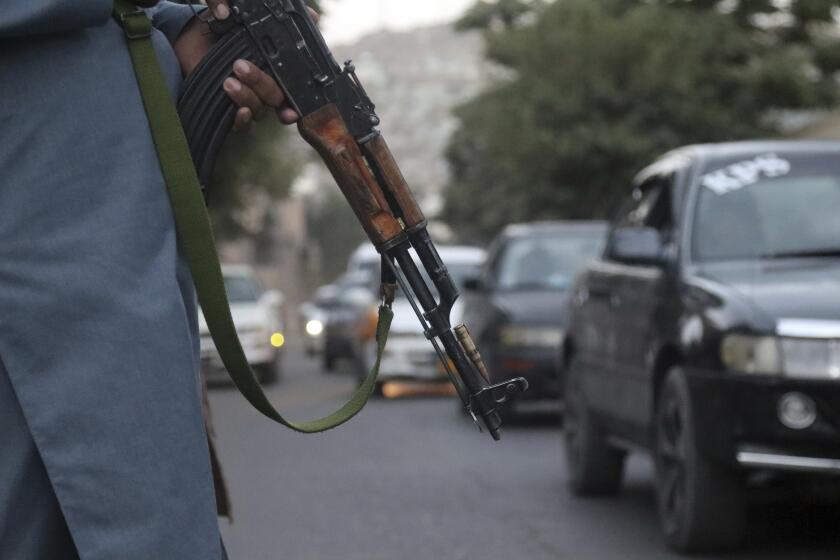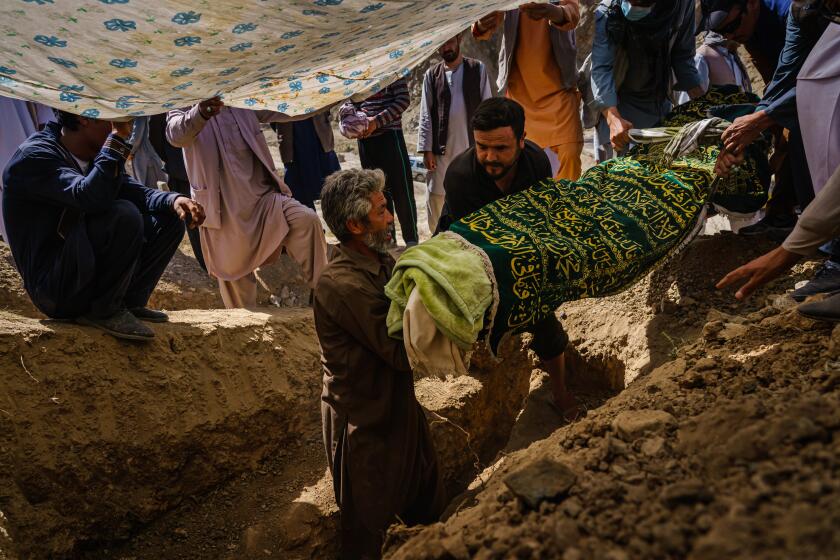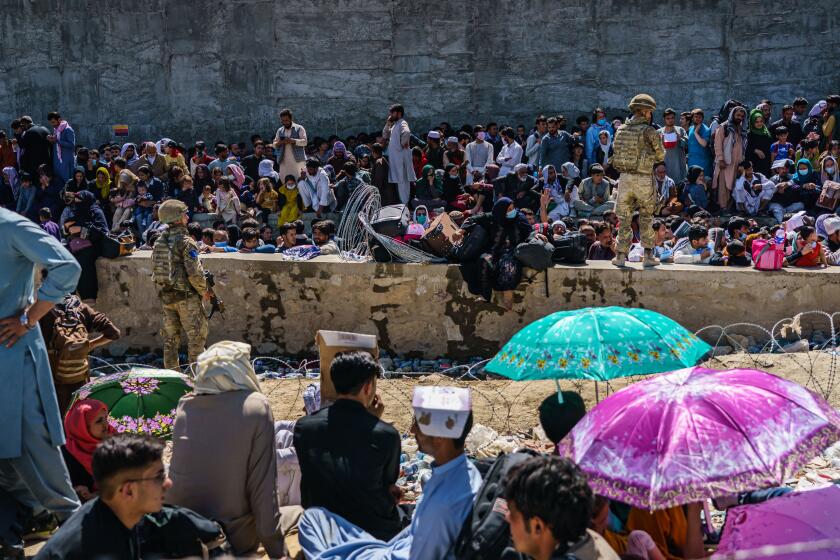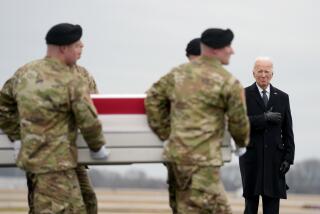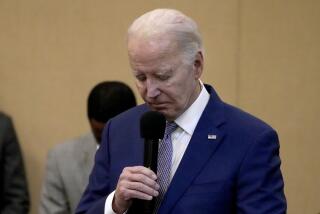Biden pledges more strikes against extremists as U.S. warns of credible threat in Afghanistan
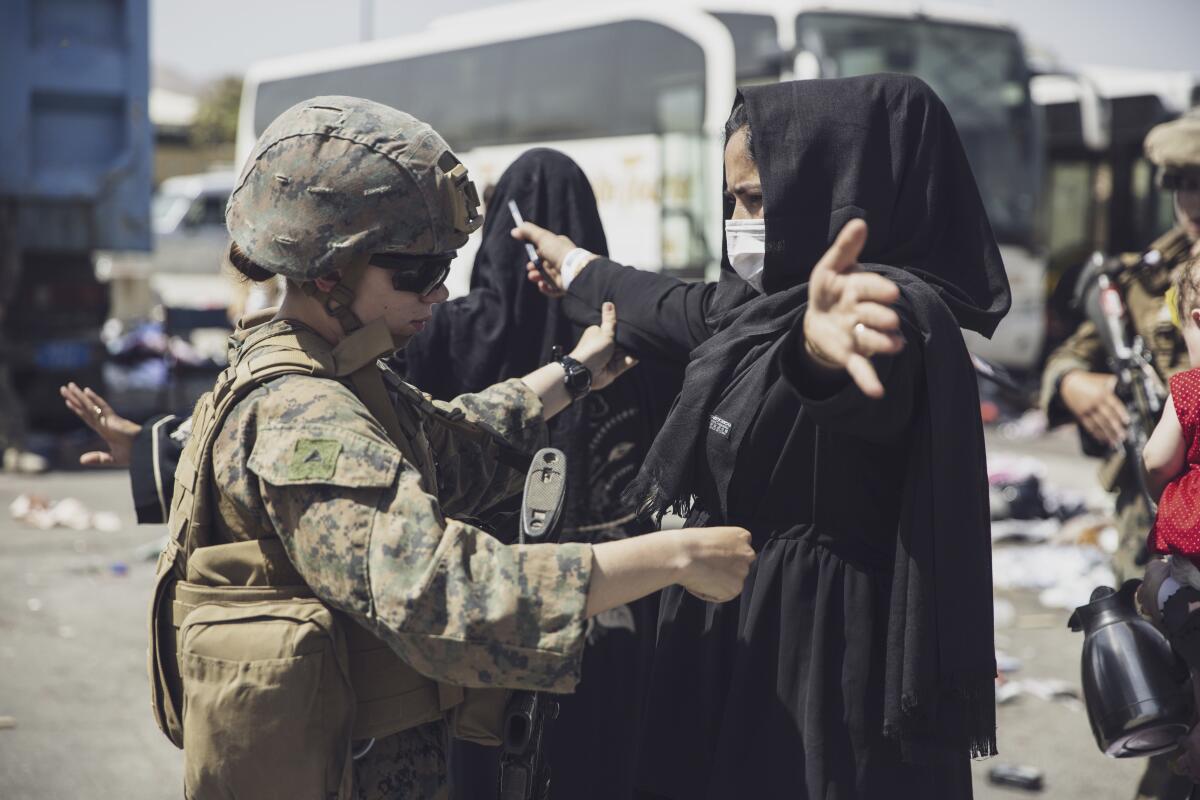
- Share via
KABUL, Afghanistan — President Biden has vowed to keep up airstrikes against an Islamic extremist group that claimed responsibility for a suicide bombing at the Kabul airport that killed scores of Afghans and 13 U.S. service members. He warned that another attack by the group was “highly likely,” and the State Department called the threat “specific” and “credible.”
The Pentagon said the remaining contingent of U.S. forces at the airport, now numbering fewer than 4,000, had begun their final withdrawal ahead of Biden’s deadline for ending the evacuation on Tuesday.
After getting briefed on a U.S. drone mission in eastern Afghanistan that the Pentagon said killed two members of the Islamic State group’s Afghanistan affiliate early Saturday, Biden said the extremists can expect more.
“This strike was not the last,” Biden said in a statement. “We will continue to hunt down any person involved in that heinous attack and make them pay.” He paid tribute to the “bravery and selflessness” of the American troops executing the hurried airlift of tens of thousands from Kabul airport, including the 13 U.S. service members who were killed in Thursday’s suicide bombing at an airport gate.
The evacuation proceeded Saturday as tensions rose over the prospect of another attack by Islamic State in Khorasan, known as ISIS-K. The State Department issued a new security alert early Sunday morning Kabul time instructing people to leave the airport area immediately “due to a specific, credible threat.”
Taliban forces have sealed off Kabul’s airport to most Afghans as NATO nations wind down their evacuation flights out of Afghanistan.
“Our commanders informed me that an attack is highly likely in the next 24-36 hours,” Biden said, adding that he has instructed them to take all possible measures to protect their troops, who are securing the airport and helping bring onto the airfield Americans and others desperate to escape Taliban rule.
The remains of the 13 American troops were on their way to the United States, the Pentagon said. Their voyage marked a painful moment in a nearly 20-year American war that cost more than 2,400 U.S. military lives and is ending with the return to power of a Taliban movement that was ousted when U.S.-led forces invaded in October 2001.
The remains of troops killed in action overseas are usually flown back to the U.S. via Dover Air Base in Delaware, where fallen troops’ return to U.S. soil is marked by a solemn movement known as the “dignified transfer.”
The White House on Saturday did not say whether Biden would travel to Dover for the troops’ return. White House Press Secretary Jen Psaki said shortly after the attack that the president “would do everything he can to honor the sacrifice and the service” of those killed.
The Pentagon released the names of the slain troops — 11 Marines, one Navy sailor and one Army soldier. Twelve of them were in the 20s; some were born in 2001, the year America’s longest war began. The oldest was 31.
They were the first U.S. service members killed in Afghanistan since February 2020, the month the Trump administration struck an agreement with the Taliban in which the militant group halted attacks on Americans in exchange for a U.S. agreement to remove all troops and contractors by May 2021. Biden announced in April that the 2,500 to 3,000 troops who remained would be out by September, ending what he has called America’s “forever war.”
With Biden’s approval, the Pentagon this month sent thousands of additional troops to the Kabul airport to provide security and to facilitate the State Department’s chaotic effort to evacuate thousands of Americans and tens of thousands of Afghans who had helped the United States during the war. The evacuation was marred by confusion and chaos as the U.S. government was caught by surprise when the Afghan army collapsed, elected government officials fled the country and the Taliban swept to power Aug. 15.
As the death toll from Thursday’s bombing in Kabul climbs past 180, Afghan families gather for funerals, and many resolve anew to leave.
About 5,400 Americans have been evacuated from the country so far, including 300 in the last day. The State Department believes about 350 more want out; it said there are roughly 280 others who have said they are Americans but who have not told the State Department of their plans to leave the country, or who have said they plan to remain.
Untold numbers of vulnerable Afghans, fearful of a return to the brutality of pre-2001 Taliban rule, are likely to be left behind. Biden and the leaders of other Western countries have said they would try to work with the Taliban to allow Afghans who had worked with them to leave after the U.S.-led evacuation ends.
The Pentagon said that about 6,800 people, mostly Afghans, were flown out in the 24 hours that ended Saturday morning, bringing to 113,500 the total number of people of all nationalities evacuated since the hurried exit began Aug. 14.
Pentagon spokesman John Kirby said the U.S. military force at the Kabul airport, which peaked at about 5,800, had begun its final withdrawal. The number had dropped below 4,000 on Saturday, according to a U.S. official who discussed details not yet publicly released on condition of anonymity. Kirby said that for security reasons the Pentagon will not provide a day-by-day description of the final stages of the military’s withdrawal, which includes flying home troops as well as equipment.
The Pentagon said an airstrike early Saturday in the eastern province of Nangarhar, which borders Pakistan, killed two ISIS-K “planners and facilitators.”
“They have lost some capability to plan and to conduct missions, but make no mistake, nobody’s writing this off and saying, ‘Well, we got them. We don’t have to worry about ISIS-K anymore.’ Not the case,” Kirby said at a news conference.
Biden also faces the problem over the longer term of containing an array of potential extremist threats based in Afghanistan, which will be harder with fewer U.S. intelligence assets and no military presence in the nation. Critics say Biden’s withdrawal from Afghanistan leaves the door open for Al Qaeda, the Islamic State and other extremist groups to grow and potentially threaten the United States. It was Al Qaeda’s use of Afghanistan as a base, with the Taliban government’s acquiescence, that prompted the United States to invade the country after the Sept. 11 terrorist attacks, beginning the longest war in U.S. history.
You can help Afghan refugees by donating money to or volunteering with organizations in California.
Saturday’s drone mission came less than two days after the Kabul airport attack and a public pledge by Biden that he would make ISIS-K “pay.” Officials made no claim that the two individuals killed played a direct role in Thursday’s suicide bomb attack.
Kirby declined to release the names and nationalities of the two killed. He said one other person was wounded in the strike. The speed with which the U.S. retaliated reflected its close monitoring of Islamic State and years of experience in targeting extremists in remote parts of the world. But it also shows the limits of U.S. power to eliminate the threat from extremists, who some believe will have more freedom of movement in Afghanistan now that the Taliban is in power.
Kirby said the U.S. had “the ability and the means to carry over-the-horizon counter-terrorism capabilities, and we’re going to defend ourselves,” referring to the military’s use of aircraft based in the Persian Gulf area and elsewhere to carry out strikes in Afghanistan.
More to Read
Sign up for Essential California
The most important California stories and recommendations in your inbox every morning.
You may occasionally receive promotional content from the Los Angeles Times.
